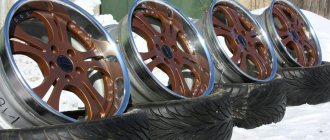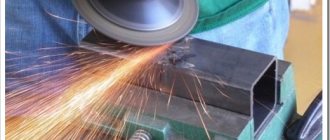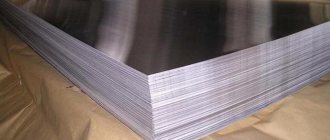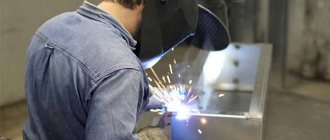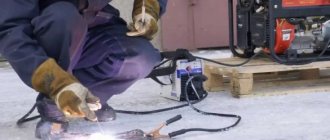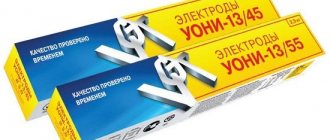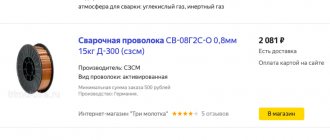- What is special about argon welding?
- Advantages of argon welding
- What disc defects can be eliminated by argon welding?
- Features of the welding process
- Preparatory procedures
- Welding process
- Recommendations
Alloy wheels give the car a stylish appearance, have a long service life, and are able to withstand high loads on uneven road surfaces. Due to their practicality, they are used on most modern cars. No matter how reliable alloy wheels may be, the poor quality of domestic roads will sooner or later lead to cracks, chips and other defects that exclude the further possibility of using the disk.
To repair and restore a damaged disk, welding work will be required. While any method is suitable for welding steel wheels, special technologies are used for light alloy wheels. One of the options that ensures complete restoration of the technical parameters of the disk is argon welding. If you cook the disc in air, the seam will be damaged in a short time and will require repeated repairs. Welding using argon eliminates oxidation of the weld, providing it with high strength and uniformity, almost like the base metal of the disk.
What is special about argon welding?
Alloy wheels contain active metals: aluminum and magnesium. Their peculiarity is that under normal conditions, during the heating process, oxidation occurs on the surface, which does not allow welding two parts in the usual way. In this case, argon-arc welding is used, which involves the use of a protective argon bath.
Argon is an inert gas and does not react chemically with heated metals during welding. The supply of this gas to the welding area creates a protective environment that prevents oxygen molecules from reaching the parts being joined. This eliminates their oxidation and allows you to obtain a strong and reliable seam, which will subsequently withstand enormous loads.
Types of damage
Alloy wheels are deservedly popular among car owners. Despite all the advantages they have, such as low weight and good heat dissipation from the brakes, these products have one significant drawback - the possibility of damage when receiving a strong blow. We must always remember that a damaged disk is a serious prerequisite for an emergency situation.
One of the reasons why damage can occur lies in the technology of its production. The thing is that these discs are produced using casting. This is why the discs become brittle and lack sufficient ductility.
As a result of this, even when receiving not the strongest impacts, cracks and chips may form on the disk. This leads to a change in the geometry of the disk and it begins to hit. After this, the car begins to “yaw” and can easily lose control, thereby creating the preconditions for a traffic accident.
The car owner must clearly understand that using a disc with some defects on a car creates a real danger for all road users, and first of all for the car owner and those who are next to him inside the car.
Damaged alloy wheel
The most common defects in alloy wheels are:
- cracks;
- displacement along the axis and radius;
- chips;
- damage to the applied coating.
Damage to disks occurs for the following reasons:
- Defects in the road surface. When a wheel falls into a hole or crack, it receives a strong blow, leading to a certain defect. Cars using low-profile tires will often suffer such damage.
- The wheel may start to spin after hitting a curb or falling into a hole. After this, a dent appears on the surface of the disk.
- Axial runout, popularly called figure eight, begins to appear after a side impact received in a collision with an obstacle, for example, a car moving in a parallel course.
- The damaged coating that is applied to the surface of the disk does not lead to obvious damage, but after a while corrosion begins to actively develop underneath it and it will be too late to repair it.
What kind of damage to alloy wheels cannot be repaired?
Before contacting a workshop that repairs alloy wheels, the car owner must know which defects cannot be repaired. What is this for? The thing is that sometimes unscrupulous craftsmen, taking advantage of the fact that the owner of the car is not always oriented in this matter, try to extract additional benefits by imposing services on the consumer that he does not need. Which, by the way, can lead to irreparable consequences.
Major changes to the geometry of the cast wheel
Even highly professional craftsmen will not undertake to correct the following defects:
- large cracks and chips;
- defects in the hub area;
- critical distortion of geometry.
Advantages of argon welding
- possibility of welding non-ferrous and active metals;
- high reliability of the resulting seam;
- the seams are a single whole with the parts being welded;
- after processing and touch-up, the seams do not stand out visually;
- oxidation of the weld is eliminated due to the use of argon protection of the welding area;
- slight heating of the parts being welded, which eliminates their deformation;
- high speed of work performed.
general information
As we wrote above, alloy wheels are very popular. Manufacturers offer many shapes and colors of discs. Such discs do not need hubcaps like stamped ones, and they have no visual defects. Any expensive car cannot be sold without alloy wheels.
Modern wheels are made from an alloy of aluminum and magnesium. Previously, the wheels were entirely aluminum, but over time it became clear that the quality of aluminum wheels is imperfect. They were not resistant to increased mechanical loads and quickly deformed, especially off-road. Therefore, magnesium was added to aluminum to keep the disc lightweight while improving its performance.
Often no more than 10-15% magnesium is added to the composition. In this case, you need to make sure that the metal grade is indicated on the disk. Knowing the brand, you can easily set up the welding mode, select the necessary electrodes and other consumables
It is very important. All repairs must be made with consumables that are made of the same metal as the disk itself
If this is neglected, the seam will turn out to be of poor quality and will quickly collapse.
What disc defects can be eliminated by argon welding?
Due to dynamic loads, various defects may appear on the wheel rims. The following can be eliminated using argon arc welding:
- cracks;
- deep faults;
- deep scratches and nicks;
- chips;
- missing disk fragments.
In the process of eliminating defects, high precision of work and professionalism of the craftsman are important. This will eliminate disc imbalance and possible beats during its operation.
Welding tips
Experienced welders give the following advice when carrying out work:
- To prevent abrasive from getting into the seam, it is advisable to cut the part with a milling cutter.
- If you cannot weld the crack in one approach, then you need to cut out the root of the seam from the back side.
- It is better to place copper or stainless steel linings on the reverse side.
- In order to reduce the stress on the part, it is necessary to heat the welded area to approximately 250-300 degrees . Laundry soap will help determine the temperature. To do this, you need to run a bar of soap over the disk and heat it. When the mark turns brown, the temperature on the disk is 250 degrees , and when it turns black, it is 300 degrees .
Features of the welding process
Welding using the protective environment of inert argon can be carried out using melting and non-melting electrodes. Their diameter is selected depending on the characteristics of the parts being connected. Depending on the composition of the metal of the disk being welded, the type of filler wire is selected. There are three methods of argon-arc welding:
- manual using a non-consumable tungsten electrode;
- automatic using argon and consumable electrodes;
- automatic using argon and non-consumable electrodes;
To repair wheel rims in auto repair shops, manual welding using a non-consumable electrode is mainly used.
Painting
The final stage of making a welding joint with your own hands is painting the disc. The powder composition is considered to be the best for painting. Of course, before you start painting, you need to clean the disc and degrease its surface. After that you need to apply a primer, and only after that start applying paint. It is best to apply several layers of paint. Now you should wait until the paint is completely dry and apply a protective varnish. This way the coating will last a long time
It is important to roll the rims before painting and eliminate runout.
On the one hand, making welding with your own hands seems as easy as shelling pears and any car owner without any engineering skills can handle it. But if you look from the other side, this is a change in the factory settings of the car’s suspension. Of course, you need to do balancing after the wide rims are fully installed, but this will not change the accelerated wear of the car.
Opinions regarding the use of welds are divided into categorical “against” and the same categorical “for”. Those who are “against” believe that welding joints lose reliability, maneuverability and increase fuel consumption and the load on the vehicle’s chassis. But those who are in favor insist that this type of disc was not so long ago used for tuning racing cars, so it cannot be unreliable and unsafe. One way or another, until you try it yourself, you probably won’t be able to find out who is right. One thing can be stated unequivocally: the main thing is to do everything wisely and “conscientiously.”
Preparatory procedures
To obtain a high-quality and reliable connection, the surfaces to be welded should initially be prepared. This process includes:
- cutting chips and cracks;
- drilling the ends of cracks to relieve excess metal stress;
- cleaning the welded surfaces from the oxide film;
- degreasing of welded edges.
If the disk repair involves welding on the missing element, care should be taken to select a patch made of metal with a similar composition as the disk itself (only homogeneous compositions need to be welded).
Repair and welding of car wheels
The most common problem that motorists face is cracks. Chips are possible, they require more attention, since in fact the disk has to be assembled from two parts, making sure that its geometry is not disturbed.
Discs without defects
When repairing cracks and chips, preparation is first made:
- Contaminants in the repair area are removed.
- The paint is peeled off at a distance of 1 cm from the damage site.
- A cut is made along the crack - the so-called “opening”, which helps to level the metal in the area of the defect and, as a result, will provide a better result.
Another option would be to drill where the crack ends and cut from the outer edge to where you drill.
The sequence of actions when repairing and welding a car wheel is as follows:
Disk repair
- After removing the tire, you need to carefully inspect everything, marking all the chips and cracks (some may be very small).
- Clean the coating down to bare metal around the work area.
- Using a grinder or other tool, cut through the crack areas.
- Clean and degrease the area of the future weld.
- Carry out welding using filler wire and argon arc welding.
- After the weld has cooled, grind it flush with the surface.
Welding process
For welding light alloy wheels, a reverse polarity mode is used.
| Rod | Application |
| 1070 | AD1, Amts |
| 1100 | AD1, Amts |
| 1450 | With the addition of titanium. Used for welding aluminum and its alloys in aircraft construction and the food industry. |
| 4043 | For welding cast Al and Si alloys AD31, AD33, AD35 (ICE blocks, base plates, frames, etc.) |
| 4047 | With the addition of silicon to increase fluidity and reduce shrinkage deformations |
| 5087 | With the addition of Zn to reduce the likelihood of hot cracks. Suitable for welding AL alloys containing up to 5% Mg |
| 5183 | Food industry, marine shipbuilding. For Al-Mg welding; Al-Mn alloys. |
| 5356 | AMg3, AMg4, AMg5, AMg6 |
| 5554 | Tanks for storing chemical materials, car frames and rims. |
| 5556 | For welding Al-Mg T-joints. |
| 5754 | For welding Al-Mg alloys. The seam has high strength and resistance to corrosion. |
A ground is connected to the disk, and a positive potential is applied to the electrode. In this case, the area of increased temperature is localized near the electrode, eliminating excessive overheating of the welded area of the disk.
The inverter sets the welding current. Welding of thin areas of the disk is carried out at a current of up to 120 A, and for the thicker part it increases to 140 A.
To form a protective inert environment, the argon supply is turned on 15...20 seconds before the start of welding. Argon should also be turned off a little after the welding process is completed - approximately after 5...10 seconds.
After applying the operating current, the torch with the electrode is brought as close as possible to the surfaces to be welded, but without contact. The optimal distance would be about 2 mm. Holding the electrode at this distance will allow you to warm up the parts being connected well (without overheating them), obtaining a high-quality and highly reliable seam.
The torch with filler wire should be moved slowly along the direction of the weld being formed. The filler wire is inserted into the arc action area without sudden movements.
During welding, care must be taken not to touch the surfaces being welded with the electrode. Electrode contact with the surface can contaminate the arc and make welding difficult.
To ignite the working arc, oscillators are used, which convert the mains current into high-frequency pulses with a voltage of 2...6 kV and a frequency of 0.15...0.5 kHz. Pulses with such parameters allow you to quickly ignite the arc without the need for contact of the electrode with the surface to be welded.
The procedure for carrying out repair work
To correct damage to alloy wheels, it is necessary to involve specialists who repair them. In addition, specialized equipment and tools will be in demand. So, you can only restore the protective coating with your own hands.
In the repair shop, approximately the following list of work will be done.
Preparation - any disk must undergo an inspection before starting work. To perform this operation, it must be cleaned of dirt and only then will all damage become noticeable.
If cracks are detected, the disc will have to be sent for welding. Welding of cast wheels is performed using equipment that allows work to be performed under the protection of inert gases. To repair discs made of aluminum, electrodes of the AG brand are used; for discs made of magnesium alloys, it is necessary to use electrodes of the AMG brand.
After all the cracks have been welded, the surface of the disk must be cleaned of welding marks. If necessary, special equipment must be used.
After cleaning the disk, its geometric parameters are checked. To do this, the finished disk is installed in a special cartridge. To restore geometric parameters, a hydraulic cylinder equipped with special attachments is used. In this way, beats and, of course, geometric parameters are eliminated.
After the defects have been eliminated, the disc will be sanded, degreased and sent for painting. Coatings that are based on epoxy resin are often used for coating.
The very last operation is balancing.
By the way, some experts strongly recommend installing disks on the rear axle.
Recommendations
Filler wire selection
The quality of the created seam largely depends on the correct choice of wire with additives. There are wires with Si, Zn, Ti additives. They are selected depending on the chemical composition of the alloy used to produce the discs. It differs from one manufacturer to another. Therefore, before welding, you need to study the technical passport of the disk, which indicates its composition, or use a special database to help, with information about the composition of the metal for the production of disks by well-known brands.
Defect cutting
In places of defects up to 3 mm deep, cutting involves the creation of V-shaped edges. In the thickened part of the disk, the crack is cut in the shape of the letter “X”. To relieve excess stress, 2 mm holes are drilled at the ends of the cracks. The chipped side needs to be leveled with a grinder.
Before surfacing a longitudinal crack, it is tedious to cut through it to prevent further cracking. For transverse cracks, it is enough to cut them to make the edges even.
Chip repair
The number of layers to be deposited depends on the depth of the chip; the length of the seam should not exceed 30 mm. The stitches of each next layer should be perpendicular to the previous one. The bead should be made with a margin to prevent the appearance of indentations after grinding the welding area.
Preparing the disc for welding work
Preparing a cast wheel for repair is not much different from what is done to work with other parts made of similar materials.
Preparing the crack edge for welding
That is, it is necessary to prepare the edges of the crack for welding. The size of the bevels that must be made depends on the thickness of the material to be welded.
